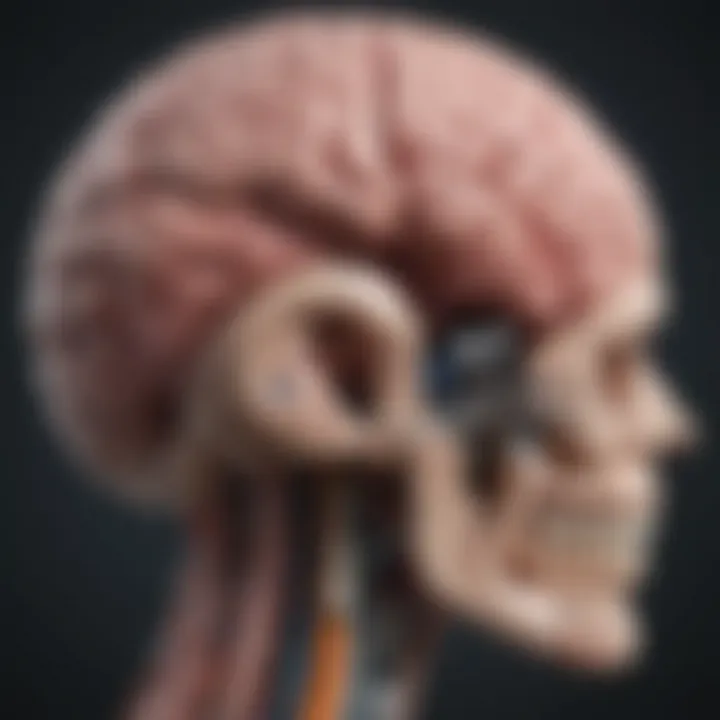Analyzing Brain Surgery Survival Rates and Outcomes


Article Overview
Purpose of the Article
This article seeks to demystify the landscape of brain surgery survival rates. Through a thorough examination of various elements, from surgical techniques to post-operative care, we aim to provide clarity on what these statistics mean for patients and their families. Ultimately, understanding these rates can help in making informed decisions concerning medical treatment and surgical options. In today’s fast-paced medical environment, knowledge of survival rates serves not only as a metric but also as a beacon of hope for many.
Relevance to Multiple Disciplines
The implications of brain surgery survival rates stretch far beyond just medical practitioners. Understanding these rates is crucial for a wide range of stakeholders:
- Patients and Families: It provides insight for patients facing surgery, equipping them with necessary information to understand potential outcomes.
- Health Care Providers: It aids in developing better pre-operative and post-operative care protocols and practices.
- Researchers: Establishing a baseline for further studies in surgical advancements, neuroscience, and treatment methodologies.
- Policy Makers: Influencing healthcare policies related to neurological care and funding.
Research Background
Historical Context
To appreciate today’s achievements in neurosurgery, one must examine the historical context that has shaped current practices. Brain surgery has a rich history, often marked by trial and error. In the early days, procedures were crude, relying heavily on rudimentary tools and techniques. However, as time has progressed, so have the methodologies.
In the mid-20th century, the introduction of advanced imaging technologies like MRI and CT scans transformed the field, enabling surgeons to visualize the brain in ways previously thought impossible. Such advancements have led to improved surgical precision, which correlates with better survival outcomes.
Key Concepts and Definitions
When discussing brain surgery survival rates, it’s essential to familiarize ourselves with some key terms:
- Survival Rate: This refers to the percentage of people who survive a specific surgical procedure over a defined period.
- Complication Rate: This indicates the frequency of adverse effects that can occur due to surgery.
- Pre-operative Care: The medical procedures and assessments performed before the surgery, which can greatly influence outcomes.
- Post-operative Care: This encompasses the treatments and therapies given to the patient after surgery, which are vital for recovery.
Understanding these concepts lays the groundwork for delving deeper into the intricacies of survival statistics and their implications, guiding readers through the puzzle of neurological surgery outcomes.
Foreword to Brain Surgery
Brain surgery is not just a medical procedure; it’s a profound journey that intertwines the intricacies of human anatomy with the advanced techniques in modern medicine. As the brain is the command center for the entire body, understanding the nuances and implications of brain surgery is essential for patients and families contemplating these life-altering operations. This section aims to lay the groundwork for comprehending why brain surgery matters, especially when it comes to survival rates—one of the most critical aspects affecting patient outcomes.
Definition and Scope
Simply put, brain surgery encompasses a variety of operations performed on the brain in response to conditions ranging from tumors to traumatic injuries. The scope of brain surgery extends beyond just the physical procedures; it includes pre-operative evaluations, imaging studies, and post-operative care. The definition is expansive and evolves as technological advancements emerge. The importance of defining such a complex topic is immense; it helps set the parameters of discussion, guiding patients and healthcare providers alike to understand what is at stake.
Key Elements:
- Types of Procedures: From craniotomies to minimally invasive endoscopic procedures, each technique has its own goals and risks.
- Patient Context: Each patient’s situation is unique; hence, factors like age, overall health, and specific conditions influence the surgical approach and outcomes.
Historical Perspective
Historically, brain surgery has come a long way from primitive methods of trepanation, where holes were drilled into the skull to release evil spirits. In the modern era, significant milestones mark the evolution of neurosurgery. By the mid-twentieth century, surgeons began utilizing advanced imaging techniques like MRI and CT scans, leading to revolutionary changes in how surgeries are planned and executed.
Notable Historical Developments:
- Introduction of Anesthesia: This breakthrough allowed for the progression from torturous procedures to those conducted under sedation, greatly improving patient comfort and outcomes.
- Advent of Surgical Microscopes: These tools provided neurosurgeons with a clearer view of brain structures, enhancing precision during operations.
- Miniaturization Techniques: The implementation of minimally invasive approaches has drastically reduced complications and recovery times.
Reading about these historical shifts not only informs us about the growth and challenges of the field but also reminds us of the ethical considerations that have arisen. The journey of brain surgery is a testament to human ingenuity, facing both triumphs and pitfalls along the way.
"In every operation, there's a delicate dance between risk and reward, requiring not just skill, but profound wisdom."
"In every operation, there's a delicate dance between risk and reward, requiring not just skill, but profound wisdom."
Understanding the path of brain surgery helps frame the discussion on survival rates, linking the past to the present and ultimately, to patient experiences today.
The Importance of Survival Rates
Survival rates play a crucial role in the realm of brain surgery—acting as a beacon for patients, families, and medical professionals alike. They are not merely figures; they encapsulate knowledge stemming from trends in surgical outcomes, innovative techniques, and the ever-evolving landscape of healthcare. Understanding these rates can be the difference between facing a daunting surgical decision with informed resolve or embarking on a path fraught with fear and uncertainty.
Defining Survival Rates
Survival rates, in the context of brain surgery, refer to the percentage of individuals who remain alive following a surgical procedure over a specified period. This metric can take various forms:
- 1-year survival rate: Often the most commonly cited, it indicates the percentage of patients alive one year post-surgery.
- 5-year survival rate: This provides a longer perspective, highlighting not only the initial recovery but potentially long-lasting successfully outcomes.
- Disease-specific survival rates: These figures further refine the data by focusing on survival related to particular conditions, such as brain tumors or aneurysms.
These rates offer insight into the effectiveness of surgical techniques, the advancements in medical technology, and the varied responses patients may have to treatments.
Interpreting Statistical Data
When it comes to statistical data regarding survival rates, there's more to consider than just the raw numbers. It’s imperative to approach this information with a discerning eye. For instance, consider the following:
- Context is key: A high survival rate for a specific procedure may mask underlying factors like patient demographics or the complexity of cases treated.
- Cohort variations: Different studies may report varying results due to the populations sampled. Factors such as age, overall health, and prior medical history significantly impact outcomes.
- Statistical significance: It's crucial to understand whether the numbers reflect a large enough sample size to be deemed statistically significant. Small sample sizes can lead to misleading implications.


A study might show an 80% survival rate for a certain procedure. At first glance, this could appear promising. However, if only a handful of patients were included in that study, the reliability of that statistic comes into question. Hence, discerning readers must delve deeper and analyze the nuances wrapped within these statistics.
"Understanding survival rates is like reading between the lines of a medical novel; the true story lies not just in the statistics but in the context surrounding them."
"Understanding survival rates is like reading between the lines of a medical novel; the true story lies not just in the statistics but in the context surrounding them."
Understanding both the definition and interpretation of survival rates can significantly empower patients and medical professionals alike. By highlighting key aspects and considerations, we navigate through a landscape that is often convoluted, gaining clarity that ultimately improves clinical decision-making and patient outcomes.
Factors Influencing Survival Rates
Understanding the survival rates following brain surgery is not a black-and-white matter. Numerous elements play a crucial role in determining outcomes, and these factors can greatly influence individual experiences during and after treatment. It's not just about the medical procedure itself but a constellation of influences that determines the trajectory of recovery. Recognizing these can greatly assist patients, families, and healthcare professionals in making informed decisions.
Patient Demographics
When we ponder on patient demographics, a few vital questions emerge. Who is undergoing the surgery? What is their age? Gender? And even ethnicity can come into play. Studies have shown that certain populations may have varying outcomes post-surgery, which opens a dialogue about equity in healthcare. Generally, younger patients demonstrate better survival rates than older individuals. This isn't merely coincidental; younger, more resilient bodies respond better to surgical interventions and endure regimens of rehabilitation more easily.
However, it does not end there. Gender differences are also present. For instance, some research indicates that males might face slightly different survival odds compared to females after brain surgeries. While these variations might seem subtle, they can make a world of difference when paired with tailored recovery plans.
"Understanding demographics provides clinicians with the insight needed to improve surgical outcomes and personalize recovery strategies."
"Understanding demographics provides clinicians with the insight needed to improve surgical outcomes and personalize recovery strategies."
Type of Brain Surgery
The type of brain surgery is another immense factor influencing patient survival rates. Not all surgeries are created equal. For example, a craniotomy, where part of the skull is removed to access the brain, carries different risks and potential complications than less invasive procedures like endoscopic surgeries.
Increasingly, the field has seen advancements toward minimally invasive techniques. These may lead to quicker recovery times and lower chances of post-operative complications. On the flip side, surgeries aimed at confronting complex conditions like brain tumors might require extensive intervention and substantially longer recovery periods.
- Craniotomy: Often necessitating longer hospital stays, these generally have higher risks associated with infections and complications.
- Endoscopic Surgery: Less invasive, may reduce risks and promote quicker recovery.
Hence, the specific method deployed can be a make-or-break factor in defining overall survival probabilities.
Pre-existing Health Conditions
Pre-existing health conditions frequently act as a hidden landmine in the landscape of surgical recovery. Conditions such as diabetes, hypertension, or cardiovascular disorders can make the body less responsive to surgical success, resulting in complications that influence survival negatively. The surgery could go flawlessly, but if an individual has a weakened immune system or suffers from chronic illness, their recovery may take a hefty toll.
With each additional health issue, there’s a proportional increase in the risk tied to the surgery.
- Cardiac Problems: Increased mortality risk during surgery.
- Respiratory Issues: Complications post-surgery can severely affect recovery timelines.
Thus, it's paramount for medical professionals to evaluate the overall health status of the patient thoroughly before recommending surgical options. This consideration not only sets the stage for more precise surgical planning but also ensures that post-operative care aligns closely with the individual’s unique health profile.
Comparative Survival Rates by Condition
When we talk about brain surgery, understanding the comparative survival rates by condition is of utmost importance. This section provides a broad look at how survival rates differ based on the specific neurological conditions underwent surgery. It serves as a guide for patients, doctors, and even researchers who want to grasp the nuances behind different surgeries and their outcomes.
Knowing these rates isn't just about numbers; it adds layers to a patient’s expectation and treatment choices. Different conditions present unique challenges and risks, influencing survival outcomes. Therefore, comparing these rates helps in making informed decisions and tailoring treatments to individual cases, which is crucial in the complicated field of neurosurgery.
Tumors
In discussing tumors, we enter a critical area of brain surgery. Brain tumors can be broadly classified into benign or malignant types.
Benign vs Malignant
The distinction between benign and malignant tumors is paramount.
- Benign tumors tend to grow slower and are usually non-cancerous, which can be a light at the end of the tunnel for patients. They’re often easier to remove surgically and generally yield better postoperative survival rates.
- Malignant tumors, on the other hand, are cancerous and often have the propensity to invade surrounding tissues and recur after initial treatment. The surgery may face obstacles, making survival rates less predictable.
This comparison is beneficial for many reasons. Understanding tumor types helps clinicians to establish comprehensive treatment plans and set realistic recovery expectations. For example, a patient with a benign tumor might not require aggressive postoperative therapies, unlike a malignant counterpart.
Aside from general characteristics, an interesting part is the location of the tumor. Some benign tumors may cause significant problems if located in critical areas of the brain, complicating their removal even though their nature is non-aggressive.
Surgical Techniques
Delving into surgical techniques, this covers the specific methodologies used to tackle both benign and malignant tumors.
Different surgical options come with their unique advantages and perceptions. For instance:
- Traditional craniotomy allows direct access to the tumor but might result in longer recovery times.
- Minimally invasive techniques, like endoscopic surgery, are gaining traction for their reduced impact on surrounding tissue, often translating into quicker recuperation periods and, in turn, potentially improved survival rates.
Choosing the right surgical avenue is critical. Surgeons weigh the benefits of direct access against the inherent risks associated with extensive procedures. Moreover, the advancements in technology aid in enhancing these surgical techniques, offering new hope for better outcomes.
Aneurysms


When we move on to aneurysms, we’re addressing another area where survival rates differ greatly. Brain aneurysms can be life-threatening, leading to severe complications if not addressed swiftly. This category of surgeries must adapt to the size, location, and type of aneurysm, which significantly influences survival statistics.
For example, larger, unruptured aneurysms generally require more complex surgical interventions. Stats can indicate that survival rates decrease markedly post-rupture, making preventive surgeries critical in retaining patient life and health.
Traumatic Brain Injuries
Lastly, traumatic brain injuries (TBIs) present a different dimension altogether. TBIs can arise from various incidents, from accidents to violence, affecting survival odds based on the injury’s severity and the patient’s health history.
Surgeons typically categorize TBIs as open or closed, where open TBIs involve a penetration through the skull, introducing higher risks.
Survival rates can swing based on immediate care, followed by surgical intervention timing. There’s no one-size-fits-all; however, coupled with rehabilitative therapies, even serious TBIs can yield favorable outcomes with proper management.
Technological Advances in Brain Surgery
In an era where medical science is continuously evolving, technological advances in brain surgery play a pivotal role in improving survival rates and patient outcomes. These innovations not only enhance the precision of surgical procedures but also reduce recovery times and minimize risks associated with interventions. As such, understanding these advancements is crucial for both medical professionals and patients alike. Below, we explore two significant advancements that are shaping modern neurosurgery.
Minimally Invasive Techniques
Minimally invasive techniques have transformed the landscape of brain surgery, providing a refreshing alternative to traditional open surgeries. These procedures, characterized by smaller incisions, result in lesser tissue damage, which can significantly reduce recovery time. For patients, this translates to shorter hospital stays and a quicker return to daily activities, making it a compelling option.
The benefits extend beyond just physical recovery; patients often experience less pain and fewer complications post-surgery. For instance, techniques such as endoscopic surgery allow surgeons to access the brain through small openings, often using specialized instruments guided by video camera systems. This precision aids in reducing the risk of infection and other postoperative complications.
Moreover, the ability to perform surgery with less invasive approaches is particularly beneficial in complex cases where traditional methods could impose dire risks. Minimally invasive procedures, such as stereotactic surgery, allow for targeted treatment of conditions like tumors or vascular malformations without necessitating extensive downtime for the patient. These techniques are becoming standard practice, showcasing how technology is leading a new era in brain surgery care.
Image-Guided Surgery
Another cornerstone of technological advance in neurosurgery is image-guided surgery. This technique employs advanced imaging technology to enhance a surgeon's navigation and accuracy during procedures. It integrates real-time imaging — such as MRI or CT scans — with the surgical approach.
Imagine a highly detailed roadmap guiding a surgeon through intricate neural pathways. That’s what image-guided surgery does; it drastically increases the margin of safety in delicate brain procedures. Surgeons can visualize the exact location of tumors, blood vessels, or other critical structures during operations. This visualization enhances outcomes considerably, especially in complex surgeries such as tumor resections where precision is of utmost importance.
The use of software that overlays the imaging data onto the surgical field allows for better decision-making. For the patient, the implication is substantial—less trauma, enhanced accuracy, and ultimately, higher survival rates. The constant interaction with updated images allows surgeons to adjust their methods on the fly, creating a dynamic surgical experience that would have been hard to imagine even a decade ago.
"Advanced imaging techniques not only promise improved precision in surgeries but also offer reassurance to patients and families about procedural safety."
"Advanced imaging techniques not only promise improved precision in surgeries but also offer reassurance to patients and families about procedural safety."
Post-operative Care and Recovery
Post-operative care is pivotal in determining the outcome of brain surgery. Surviving the surgery is the first hurdle; the next challenge lies in ensuring a smooth transition to recovery. The recovery process is intricately linked to both immediate monitoring and long-term care strategies. A well-structured post-operative care plan can significantly influence overall survival rates while also enhancing the quality of life in patients.
Immediate care entails close observation of patients as they wake up from anesthesia. This stage is critical as it involves monitoring vital signs and neurological status to identify any complications early. Long-term care, on the other hand, revolves around rehabilitation, adjustments in daily living, and follow-up appointments that ensure comprehensive recovery.
Immediate Post-operative Monitoring
The period right after a brain surgery is comparable to walking a tightrope, where the balance between progress and setbacks can swiftly shift. During this immediate phase, healthcare providers focus on a range of crucial parameters, including:
- Vital Signs: Continuous checks on heart rate, blood pressure, and oxygen levels.
- Neurological Assessments: Tests conducted to evaluate consciousness, motor skills, and response to stimuli.
- Fluid Management: Ensuring that patients are adequately hydrated and that fluid imbalances are corrected.
- Pain Management: Strategically managing pain through medications to promote comfort without causing excessive sedation.
It cannot be stressed enough: the first 24 to 48 hours post-surgery are some of the most decisive moments in the recovery process.
It cannot be stressed enough: the first 24 to 48 hours post-surgery are some of the most decisive moments in the recovery process.
Swift action in monitoring allows prompt intervention if any abnormal signs appear, minimizing risks associated with complications such as infection, seizures, or blood clots. The goal here is to catch potential issues before they escalate.
Long-term Care Strategies
Once the immediate crisis is behind, the focus shifts to long-term care strategies that aim to restore function and improve the overall well-being of the patient. This encompasses a variety of approaches:
- Rehabilitation Therapy: Tailored programs involving physical, occupational, and speech therapy help individuals regain lost functions and adapt to any changes in their condition.
- Follow-up Care: Regular medical check-ups are essential. These appointments allow doctors to monitor recovery progress and adjust medications or therapies accordingly.
- Psychosocial Support: Mental health is often overlooked, yet emotional well-being is vital. Support groups and counseling can help patients adjust to life post-surgery, addressing common issues like anxiety or depression.
- Lifestyle Modifications: Educating patients on nutrition, exercise, and cognitive demands plays a critical role in long-term outcomes. Adopting a healthier lifestyle can improve overall resilience and recovery speed.
- Family Involvement: Engaging family members in the recovery process fosters a supportive environment that can significantly affect the patient's outlook and adherence to post-operative guidelines.
Understanding the significance of robust post-operative care, from immediate monitoring to long-term recovery strategies, highlights how central these elements are in shaping survival outcomes in brain surgery. Patients who receive attentive care and management can often navigate their recovery more successfully, turning challenges into comebacks.
Global Perspectives on Survival Rates
The exploration of survival rates in brain surgery extends beyond clinical outcomes; it also invites a broader understanding from a global standpoint. The variations in survival rates across different regions not only indicate the effectiveness of medical practices but also reflect the socioeconomic factors and healthcare systems in place. By considering how various countries approach brain surgery, we gain insights that are essential for improving patient outcomes and establishing effective protocols worldwide.
Variations by Country
When we look at survival rates for brain surgery around the world, the disparities can be quite striking. For instance, countries like Germany and Japan often report higher survival rates for neurosurgical procedures compared to those in developing nations. This discrepancy can often be attributed to factors including:
- Healthcare Infrastructure: Advanced medical facilities in developed nations are equipped with cutting-edge technology and skilled professionals, fostering better patient care.
- Access to Care: In countries where healthcare is more accessible, patients are more likely to receive early interventions, which are crucial in improving survival outcomes.
- Insurance and Funding: In regions with comprehensive insurance coverage, the financial burden of brain surgeries is less significant, allowing more individuals to seek necessary treatments.
According to various studies, the survival rate for patients undergoing procedures for brain tumors may be as high as 80% in countries with robust medical resources. In contrast, some regions in Africa and parts of South Asia report much lower rates, often below 50%. This raises questions about equity in healthcare and highlights the necessity for international collaboration to elevate standards of care globally.


International Protocols and Guidelines
Global perspectives also reveal a landscape rich in diversity when it comes to protocols and guidelines for brain surgery. Various organizations and healthcare bodies have developed their own standards based on localized need and capabilities. For instance:
- The World Federation of Neurosurgical Societies plays a critical role in disseminating best practices through guidelines that emphasize patient safety and optimal surgical practices.
- National Neurosurgical Associations frequently tailor these protocols to address specific regional issues, including available technology and surgeon training.
These guidelines may cover areas such as:
- Pre-operative assessments: Ensuring that patients are adequately evaluated to mitigate risks associated with surgery.
- Post-operative care: Establishing protocols for monitoring patients and addressing complications, differentiating approaches in developed versus developing healthcare settings.
A systematic review of international practices suggests that consistent adherence to established guidelines results in noticeably improved survival rates. It underscores the significance of communication and sharing successful strategies across borders, making a case for a unified approach to brain surgery best practices.
"Understanding global perspectives on survival rates not only broadens our comprehension of healthcare disparities but also challenges us to adopt and adapt successful practices that can bridge the gap."
"Understanding global perspectives on survival rates not only broadens our comprehension of healthcare disparities but also challenges us to adopt and adapt successful practices that can bridge the gap."
Addressing these aspects provid crucial insight into how countries can learn from each other to improve their own survival rates in brain surgery. This discussion is not merely academic; it has the potential to save lives.
The Role of Rehabilitation in Recovery
Rehabilitation plays a critical role in the recovery process for patients undergoing brain surgery. It is not merely a follow-up; it is an essential part of the healing journey that helps restore function and enhance patients’ quality of life. The challenging nature of brain surgery means that post-operative care must not only address the physical aspects of recovery but also cognitive and emotional challenges patients might face. In this section, we will delve deeper into the various elements of rehabilitation and examine how they contribute significantly to a patient’s recovery journey.
Physical Rehabilitation
Physical rehabilitation encompasses a wide range of practices designed to restore mobility and strength after brain surgery. Depending on the type of surgery performed, patients may experience weakness, balance problems, or reduced coordination. Here are several key aspects of physical rehabilitation:
- Strength Training: Tailored exercises help regain muscle strength that may have diminished due to surgery.
- Balance Exercises: Exercises aimed at improving stability are crucial, as balance issues can greatly affect a patient’s day-to-day activities.
- Mobility Training: Learning to walk again may be necessary for some patients, and therapists utilize various techniques to assist in this process.
- Adaptive Techniques: For those with significant mobility restrictions, physical therapists introduce strategies and adaptive equipment to facilitate independence.
Rehabilitation specialists utilize assessments to determine individual needs and devise a personalized recovery plan. Overall, successful physical rehabilitation can help patients return to their routine activities, encouraging a sense of normalcy and self-reliance.
Cognitive Rehabilitation
Cognitive rehabilitation focuses on helping individuals regain their mental faculties following brain surgery. Cognitive deficits can vary significantly between patients, ranging from memory loss to executive function impairments. Key components include:
- Memory Exercises: Techniques to improve memory retention are often used, such as memory aids and practice activities.
- Attention Training: Strategies to enhance focus and concentration are crucial as many patients find it challenging to sustain attention post-surgery.
- Problem-Solving Skills: Cognitive tasks that mimic real-life situations can help restore the ability to think critically and make decisions.
- Emotional Support: Addressing psychological well-being is just as essential. Providing support may help mitigate feelings of anxiety or depression that can arise during recovery.
Effective cognitive rehabilitation often involves family members and caregivers, as they play a pivotal role in providing support and reinforcement in a familiar environment. Holistic recovery that integrates both physical and cognitive therapies leads to better overall outcomes.
"The brain is resilient, but it requires a robust rehabilitation framework to unlock its full potential post-surgery."
"The brain is resilient, but it requires a robust rehabilitation framework to unlock its full potential post-surgery."
As patients transition back into their daily lives, a well-structured rehabilitation program not only facilitates recovery but also empowers individuals, helping them navigate the complexities of life after brain surgery. Through dedicated rehabilitation efforts, patients can build upon their pre-surgery capabilities, significantly improving their quality of life.
Ethical Considerations in Brain Surgery
In the realm of medical interventions, especially complex ones like brain surgery, ethical considerations take center stage. This section examines the moral framework governing such sensitive procedures, underscoring the critical importance of ethics in ensuring patient well-being and trust. When discussing survival rates, it becomes apparent that the ethics surrounding brain surgeries are multilayered. An important part of assessing surgeries is understanding how the ethical aspects can influence decision-making, treatment choices, and ultimately, patient outcomes.
A key element in this discussion is informed consent. Patients, along with their families, must be adequately informed about the risks, benefits, and potential outcomes of brain surgery. This goes beyond merely signing a form; it encompasses a comprehensive understanding of the procedure and its implications for the patient's life. For instance, imagine a patient diagnosed with a complex brain tumor. The discussing surgeon not only needs to explain the technical aspects of tumor removal but also address potential complications that could arise post-surgery, such as physical disabilities or cognitive impairments. This ensures that patients can make educated choices regarding their treatments, aligning with their personal values and life circumstances.
Moreover, patient autonomy cannot be overlooked. Patients have the fundamental right to participate in decisions affecting their health. In an environment where high-tech advancements are prevalent, it’s essential not to forget the human element. Autonomy means acknowledging the patient’s preferences, fears, and expectations. Often, patients might feel overwhelmed by medical jargon or the gravity of their conditions. Encouraging discussions that normalize expressing doubts or questions builds a collaborative atmosphere. For instance, consider the situation where a patient may prefer a less invasive procedure despite lower survival predictions than a more aggressive option. Respecting that choice fosters trust and endorses a shared decision-making process, pivotal in the patient-surgeon relationship.
Maintaining a balance between medical advisement and respecting a patient's wishes is the foundation of ethical healthcare.
Maintaining a balance between medical advisement and respecting a patient's wishes is the foundation of ethical healthcare.
In summary, addressing the ethical considerations in brain surgery can significantly influence both the approach to treatment and the patient's experience. Recognizing the importance of informed consent and promoting patient autonomy ensures that individuals have a say in their healthcare journeys, which can be transformative in their recovery and overall satisfaction. As advances continue to shape the landscape of neurosurgery, embedding ethics into practice remains a necessity for instilling confidence in patients and improving outcomes.
Future Trends in Neurosurgery
As we look toward future trends in neurosurgery, it becomes evident that the field is on the brink of a major evolution. Understanding these trends not only helps medical professionals stay ahead of the curve but also empowers patients and their families to make informed decisions about their treatment options. With ongoing technological advancements and innovative research guiding the future, survival rates and overall quality of care are expected to improve significantly. In this section, we will explore undercurrents shaping neurosurgery, the drive for innovative techniques, and the anticipated impact on survival rates.
Innovative Techniques on the Horizon
Innovation lies at the heart of neurosurgery's progression. A host of techniques are emerging that promise to change the way surgeries are performed and how patients recover. Here are a few notable developments gaining traction:
- Robotic Assistance: Robotics is unlocking new possibilities. Utilizing robotic systems for procedures can enhance precision, minimize incisions, and reduce recovery time. For instance, systems like the da Vinci Surgical System are becoming more common in various surgical settings, and their adaptability makes them ideal for intricate brain tasks.
- Augmented Reality (AR): This cutting-edge technology is providing surgeons with enhanced visualization during operations. By overlaying critical information in real-time, AR can help enhance spatial awareness, leading to better decision-making and improved outcomes.
- Biomaterials: The emergence of advanced biomaterials plays a crucial role in tissue engineering and repair. Innovations in materials can improve graft compatibility and reduce the chances of rejection, paving the way for more successful surgeries.
- Gene Therapy: While still largely experimental, gene therapy has the potential to revolutionize how certain brain conditions are treated. By addressing issues at the genetic level, there may be opportunities for more effective and less invasive treatment options.
Potential Impact on Survival Rates
As these innovative techniques become integrated into everyday neurosurgical practices, the potential impact on survival rates cannot be understated. A few key points to consider:
- Minimized Risks: Most new surgical techniques are designed with safety as a priority. With less invasive methods, the risks associated with complications can be dramatically reduced, offering a significant advantage for patient survival.
- Faster Recovery: The incorporation of minimally invasive approaches directly influences recovery time. Patients can often resume their normal lives quicker, which contributes positively to long-term survival and general wellness.
- Tailored Treatments: Personalized medicine is gaining traction in neurosurgery. Tailoring treatments to each individual’s genetic makeup and disease specifics can enhance efficacy and improve outcomes, thus potentially raising survival rates overall.
- Optimized Patient Care: The integration of advanced technologies not only affects surgical procedures but also enhances pre and post-operative care. Protocols can be adapted based on real-time monitoring, which plays a critical role in recovery strategies and can significantly affect survival chances.
In summary, while the immediate future of neurosurgery may still hold uncertainties, the drive toward innovation is well underway. Embracing these techniques paves the way for enhanced surgical outcomes and better survival statistics, benefitting patients and the larger medical community alike.
In summary, while the immediate future of neurosurgery may still hold uncertainties, the drive toward innovation is well underway. Embracing these techniques paves the way for enhanced surgical outcomes and better survival statistics, benefitting patients and the larger medical community alike.
As research continues to unfold, the journey towards improved survival rates in brain surgery remains a focal point of medical exploration.



